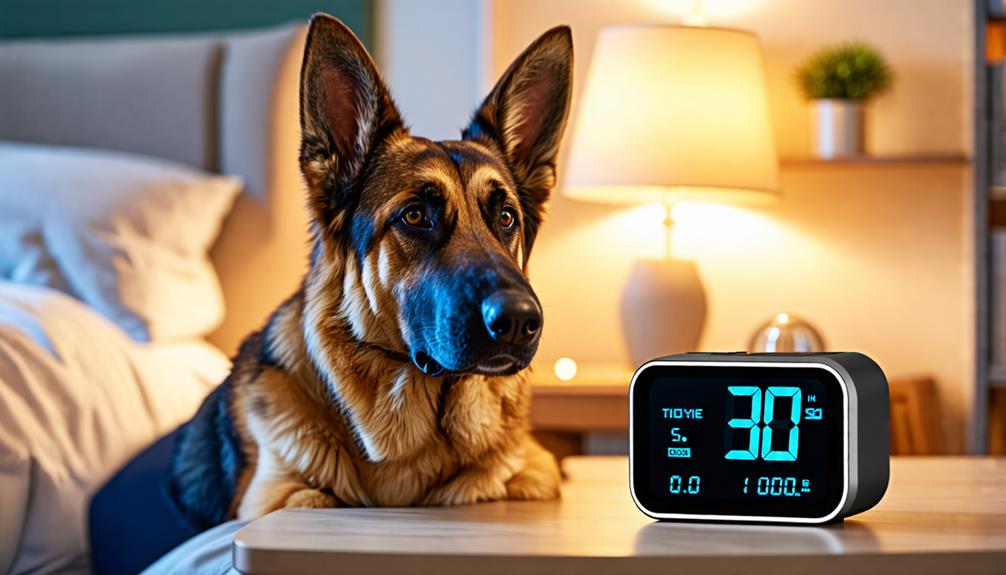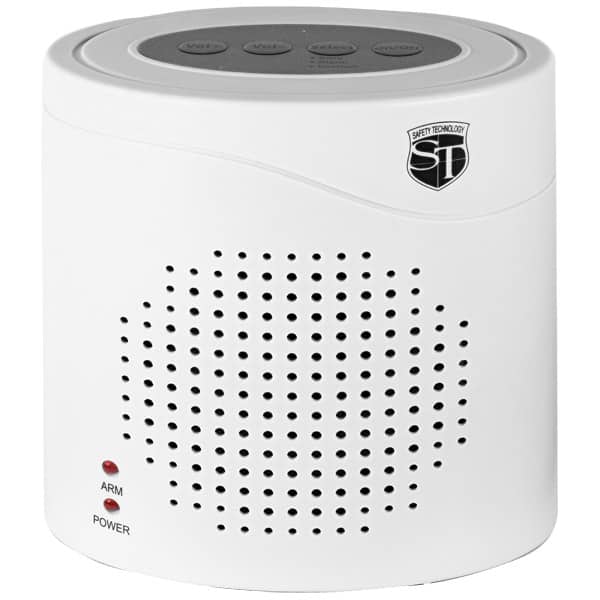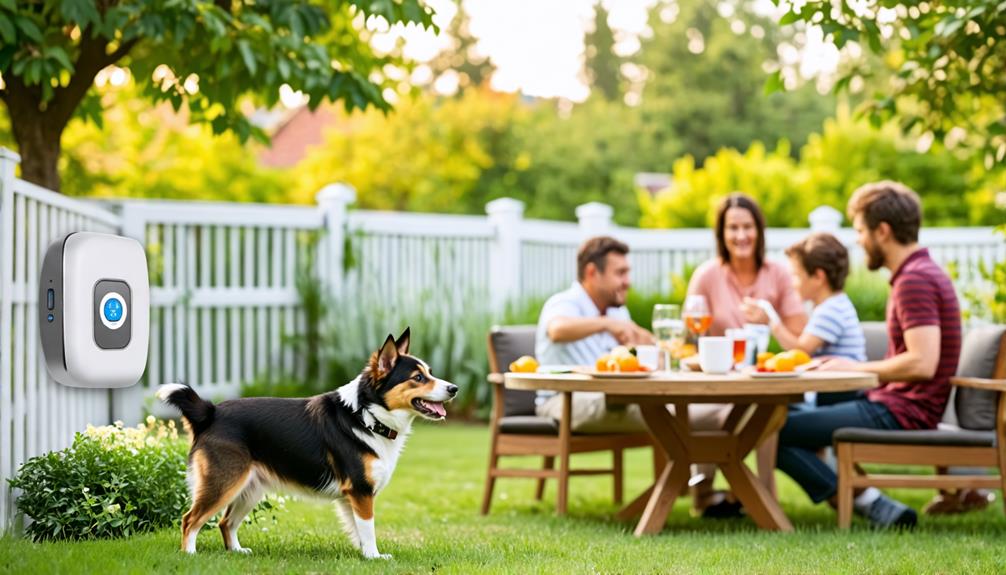
Brainstorm Security Shop

For Orders Over $199

On Any Of Our Products

Details On Refund Page
As you consider ways to manage your dog’s persistent barking, you might find yourself exploring the variety of dog barking deterrent devices available on the market. From ultrasonic tools that emit a sound only dogs can hear, to vibration collars that gently alert your pet to quiet down, each type offers a unique approach to address the issue. However, it’s essential to weigh their effectiveness against your dog’s specific needs and temperament. Before you decide on the best option, let’s examine how these devices actually work and what makes one choice potentially more suitable for your furry friend than another. What could be the implications for your dog’s behavior and overall well-being?
When addressing the issue of excessive dog barking, you’ll find several types of deterrents available that can help manage this behavior. Understanding barking triggers is essential as it allows you to select the most effective method tailored to your dog’s needs.
One popular approach is using citronella collars, which release a burst of citronella spray when your dog barks. The unexpected scent acts as a distraction and discourages further barking. This method is preferred by many pet owners because it’s non-invasive and uses natural ingredients.
Another effective tool is vibration collars, which emit a vibration on your dog’s neck when they bark. This sensation, though harmless, is meant to interrupt your dog’s barking and redirect their focus.
It’s crucial to combine these devices with training techniques to ensure they understand why their behavior is being corrected.
Training techniques themselves can also act as deterrents. By teaching commands like “quiet” or “stop,” you can control your dog’s barking without the need for additional devices.
Positive reinforcement, such as treats and praise, should be used to reward silence or cessation of barking, reinforcing quiet behavior over time.

Exploring ultrasonic devices reveals how they use high-frequency sound waves to deter barking. When you’re dealing with a persistently barking dog, these gadgets can be a real lifesaver.
They work by emitting a sound at an ultrasonic frequency, which is typically above 20,000 Hz. This range is inaudible to most humans but can be quite annoying to dogs.
Here’s how it functions: once a dog starts barking, the device detects the noise and activates. It then releases a sharp, high-pitched sound that only your dog can hear. This sound doesn’t harm them but grabs their attention and makes them uncomfortable enough to stop barking.
Over time, your furry friend starts associating their barking with this unpleasant noise and is conditioned to bark less.
It’s important to understand that these devices aren’t one-size-fits-all. Some dogs might be more sensitive to ultrasonic frequencies than others.
Moreover, the effectiveness can also depend on the range and angle of the device relative to the dog. Placement and environment play crucial roles in ensuring that the ultrasonic sound waves are effectively delivered to curb the barking behavior in your dog.
Switching to spray collars offers a gentle yet effective alternative to manage excessive barking. These devices utilize a burst of spray, typically citronella or unscented mist, to interrupt and deter your dog from barking unnecessarily.
You’ll find spray collar effectiveness hinges on its non-intrusive method, which taps into your dog’s sense of smell and surprise without causing harm.
The dog training benefits are considerable. Spray collars teach self-control and can be used in conjunction with positive reinforcement. By associating the spray with excessive barking, your dog learns to curb this behavior, leading to a quieter environment and less stress for both of you.
It’s a humane approach that prioritizes your dog’s welfare, making it an ideal choice for owners who are hesitant about more punitive methods like shock collars.
Moreover, these collars are adaptable to different settings and situations, providing you with flexibility in training. Whether you’re at home or in a public space, the spray collar remains effective, ensuring consistent behavior modification.
This adaptability enhances the overall utility of the device, embedding it as a valuable tool in your dog training arsenal.
Selecting the appropriate dog barking deterrent device requires considering your pet’s size, temperament, and the specific circumstances leading to excessive barking.
It’s crucial to match the device to these factors to ensure it’s effective and humane. When it comes to device features, look for options that suit your dog’s learning style and your lifestyle. For example, if you’re often away, a device with automatic detection and response might be ideal.
User reviews are invaluable when choosing the right device. They provide real-world insights into how different models perform in various environments and with different dog breeds.
Pay attention to reviews that discuss the device’s effectiveness, ease of use, and durability. However, you should weigh these reviews carefully, considering the context of each user’s experience.
Lastly, consider the practicality of the device. You’ll need something easy for you to operate but complex enough not to be manipulated by your dog.
The right device should seamlessly integrate into your daily routine, enhancing peace without causing undue stress for either you or your pet.
After choosing the right dog barking deterrent device, it’s important to consider its safety and effectiveness. You’ll want to ensure that the method you select not only reduces barking but does so without harming your dog. Consider the following key points:
This approach helps avoid any negative psychological effects and promotes a healthy learning environment.
Similarly, avoid gadgets that deliver electric shocks or cause physical discomfort, as these can have serious long-term health effects.
The goal is to find a deterrent that effectively reduces barking while ensuring that your dog remains happy and healthy.

You might be concerned about the long-term effects on your dog’s mental health from using certain devices.
These gadgets can indeed lead to behavioral changes. Continuous exposure might cause stress or anxiety, potentially affecting your dog’s overall well-being.
It’s crucial to consider gentler alternatives and consult with a vet or a pet behaviorist to ensure the safety and happiness of your furry friend.
Always prioritize your pet’s health and emotional stability.
You might wonder if barking deterrents work for all dog breeds.
The effectiveness largely depends on specific breed behavior and individual barking triggers. Some breeds might respond well due to their sensitivity to certain stimuli, while others may ignore the deterrents altogether.
It’s crucial to understand your dog’s personality and the reasons behind their barking to choose the most effective solution.
Always consider a method that’s safe and humane for your pet.
If you’re seeking alternatives to electronic deterrents for managing your dog’s barking, consider training collars that use vibration or sound instead of shocks.
Additionally, engaging in behavioral modification techniques, such as positive reinforcement when they’re quiet, can be highly effective.
You could also explore environmental adjustments to reduce stimuli that trigger barking, or consult a professional dog trainer for personalized guidance and strategies tailored to your dog’s specific needs and temperament.

When you’re considering how your neighbors might react to ultrasonic devices, it’s essential to gauge their noise tolerance.
Some may find the high-frequency sounds emitted by these devices just as disruptive as the barking they’re meant to curb.
It’s a good idea to discuss it with them beforehand to avoid any unpleasant confrontations.
Open communication can help ensure that the solution you choose doesn’t lead to further neighborhood discord.
You might wonder if a system can tell the difference between a dog’s bark and other sounds it makes.
Unfortunately, most devices aren’t that sophisticated. They generally can’t distinguish between barking patterns and other noises due to their focus on certain sound frequencies.
This lack of specificity can lead to the device activating in response to any loud sound, not just barking, potentially causing confusion or unnecessary distress for your dog.
You’ve got various options for managing your dog’s excessive barking with devices tailored to their unique temperament. Whether you opt for ultrasonic devices, spray collars, or vibration options, ensure they’re used responsibly alongside positive reinforcement. By choosing the right tool and combining it with consistent training, you’ll not only maintain your dog’s well-being but also foster better behavior. Remember, safety and effectiveness are paramount, so select carefully and monitor your dog’s response to find the best fit.

Brainstorm Security Shop
1867 Caravan Trail
Ste 105
Jacksonville, FL 32216
Call us toll free: (800) 859-5566